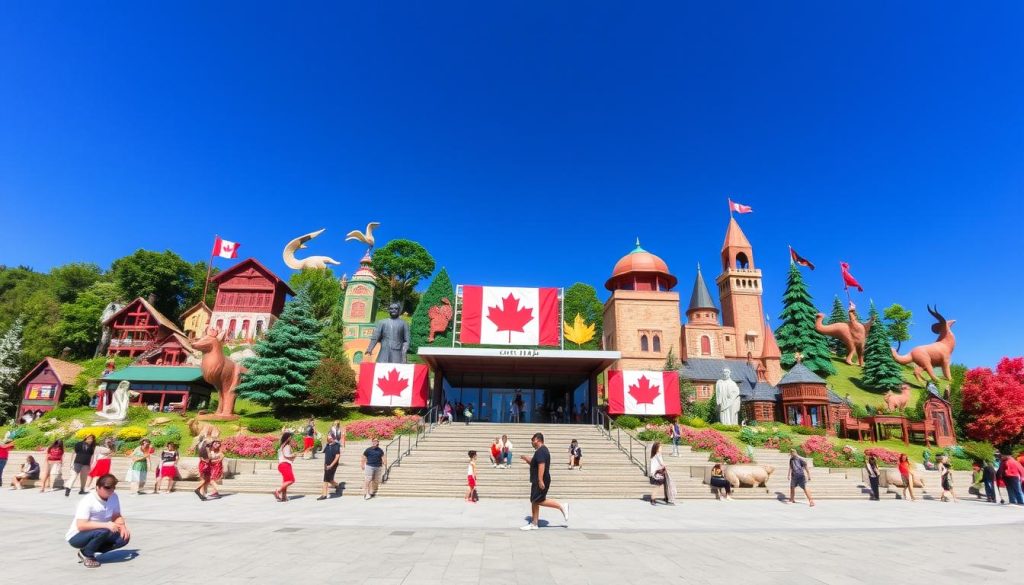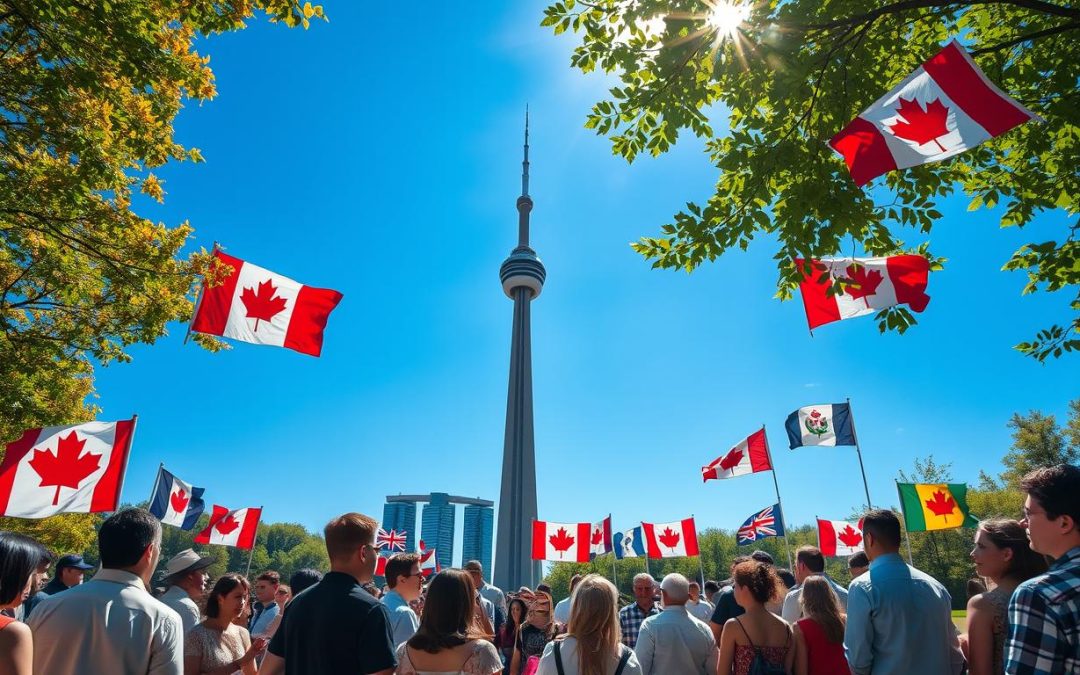Did you know Canada’s language scene is more than just English and French? It’s a country where language diversity is a living, breathing part of its culture. This diversity shows off Canada’s rich history and its ties to the world.
Canada’s official languages paint a picture of cultural complexity. The country values both English and French, making communication and understanding key parts of its language policy.
The 2021 census shows 98.2% of Canadians can speak one or both official languages. This highlights Canada’s dedication to language inclusivity and respect.
Exploring Canada’s language diversity will show you how official languages shape the country’s identity. They help share cultural details and connect communities across this vast land.
Key Takeaways
- Canada has two official languages: English and French
- 98.2% of residents speak at least one official language
- Language policies ensure equal status for English and French
- Linguistic diversity extends beyond official languages
- Canada’s language landscape reflects its multicultural identity
Understanding Canada’s Linguistic Landscape
Canada is a vibrant mosaic of languages, where policy and culture blend to form a unique identity. Exploring Canada’s language scene shows a complex and rich world of communication and culture.
The country’s language scene is marked by bilingualism and multiculturalism. With English and French as official languages, Canada promotes inclusivity in language.
Historical Evolution of Language Policy
Canada’s language policy grew from interactions between Indigenous peoples, French settlers, and British colonizers. Important moments include:
- The Official Languages Act of 1969
- Constitutional recognition of English and French
- Commitment to linguistic equality
Cultural Impact of Bilingualism
“Language is the roadmap of a culture. It tells you where its people come from and where they are going.” – Rita Mae Brown
Bilingualism in Canada is more than just talking. It’s about deep cultural understanding and respect. Knowing both English and French can lead to better social and professional ties.
Current Language Demographics
Canada’s language scene is changing with immigration and global trends. Here are some interesting facts:
| Language | Percentage of Population |
|---|---|
| English | 56.9% |
| French | 21.3% |
| Other Languages | 13% |
Almost one in four Canadians speak a language other than English or French. This makes Canada a global example of language diversity and inclusion.
English Language in Canada

Canada’s main language is English, covering the whole country. In 2021, about 21.5 million Canadians spoke English at home most often. This makes up 65% of the population. English is a key tool for connecting different communities across the country.
Canadian English is special, with its own words, sounds, and spellings. These reflect Canada’s rich culture. English is vital in education, business, and media from British Columbia to Ontario.
“English in Canada is more than just a language – it’s a cultural connector that brings people together.”
Key English Language Statistics
| Statistic | Percentage |
|---|---|
| Native English Speakers | 55.9% |
| Canadians with English Conversation Skills | 86.2% |
| English Speakers at Home | 63.8% |
Regional English Language Insights
- Toronto boasts widespread English usage among locals and tourists
- Vancouver has approximately 70% English-speaking population
- British Columbia demonstrates strong English language prevalence
While English is the main language, Canada values its diverse languages. English lives alongside French, Indigenous languages, and languages from immigrants. This creates a lively and multicultural communication scene.
Understanding the English language in Canada means appreciating its role as a unifying force across diverse communities.
French Language Status and Distribution
Canada’s linguistic landscape is rich with French heritage. The French language is key to the country’s identity. It shapes the cultural mosaic. About 10 million Canadians speak French as their first language, showing a vibrant community.
The spread of French speakers in Canada shows interesting patterns. Quebec is the main area for French, but communities are found everywhere.
Quebec’s French Language Policies
Quebec is the heart of French in North America. Here are some key facts:
- 85% of Quebec’s people are native francophones
- 95% speak French as their first or second language
- 71.2% are first language francophones
French-Speaking Communities Outside Quebec
Outside Quebec, French speakers keep their identity in different provinces:
| Province | Francophone Population | Percentage |
|---|---|---|
| New Brunswick | 234,410 | 33.3% |
| Ontario | 561,160 | 4.4% |
| Manitoba | 47,680 | 3.8% |
Historical French Settlement Impact
The early French settlements have greatly shaped Canada’s language scene. About 1 million native francophones live outside Quebec. This creates a rich mix of cultures and languages that define the nation.
“Language is the roadmap of a culture. It tells you where its people come from and where they are going.” – Rita Mae Brown
Indigenous Languages and Their Preservation

Canada’s Indigenous languages are a treasure of cultural heritage and diversity. In 2021, about 237,420 Indigenous people could speak their traditional languages. This shows the ongoing effort to keep these languages alive. These languages are more than just a way to communicate; they connect us to our ancestors and our cultural identity.
The Indigenous languages in Canada are diverse and vibrant. There are 60 distinct languages, divided into 12 families, with the Algonquin family being the largest. Some important Indigenous languages include:
- Cree: Approximately 100,000 total speakers
- Inuktitut: Around 38,000 native speakers
- Ojibway: Over 25,000 speakers
- Mi’kmaq: Approximately 9,000 speakers
Despite their rich heritage, Indigenous languages face big challenges. The number of Indigenous people speaking their native languages dropped from 15.0% in 2016 to 13.1% in 2021. This shows how urgent it is to save these languages.
“Language is the roadmap of a culture. It tells you where its people come from and where they are going.” – Rita Mae Brown
Community-led efforts are key in bringing back Indigenous languages. In 2021, over 27.7% of Indigenous language speakers learned their language as a second language. This shows a growing effort to save these languages.
| Language Family | Number of Languages | Notable Languages |
|---|---|---|
| Algonquin | Multiple | Cree, Ojibway, Innu |
| Iroquoian | Several | Mohawk, Oneida |
| Inuit | Limited | Inuktitut |
Your support is crucial in saving these precious languages. By learning, promoting, and celebrating Indigenous languages, we can keep Canada’s cultural diversity alive.
Canada’s Official Language Policies
Canada’s language policies show a complex and inclusive approach to linguistic rights. The country values cultural diversity and national unity deeply. This is more than just rules; it’s a respect for different cultures.
The Official Languages Act is the heart of Canada’s language policy. It was passed on September 9, 1969. It made English and French equal in government services and courts.
Federal Language Services
Federal language services help Canadians talk to government in their preferred language. Key points include:
- English and French have equal status in federal institutions
- Both languages are guaranteed by the Constitution
- There’s a focus on involving linguistic minority communities
Provincial Language Rights
Language rights differ in provinces, showing unique regional needs:
- New Brunswick: It’s constitutionally bilingual, with English and French equal
- Quebec: French is the official language, with English minority rights
- Manitoba: It must offer services in both languages by Supreme Court order
Territorial Language Policies
Territories like Nunavut have special language policies. They include Indigenous languages with English and French. This honors Canada’s northern linguistic heritage.
“Language is the road map of a culture. It tells you where its people come from and where they are going.” – Rita Mae Brown
Canada’s language policy keeps evolving. It shows a dedication to inclusivity, cultural preservation, and respect among languages.
Immigration’s Impact on Language Diversity

Immigration has changed Canada’s language scene a lot. The country’s mix of cultures has woven a colorful language tapestry. In 2021, 4.6 million Canadians spoke a language other than English or French at home. This made up 12.7% of the population.
Canada’s language mix keeps changing with new immigrants. Key points include:
- Over 70 different languages are actively spoken across the country
- South Asian languages have experienced explosive growth
- Mandarin and Punjabi have become increasingly prominent
“Language is the roadmap of a culture. It tells you where its people come from and where they are going.” – Rita Mae Brown
The growth of language groups shows Canada’s dedication to diversity. Look at how South Asian languages have grown:
| Language | Growth Rate (2016-2021) |
|---|---|
| Malayalam | 129% |
| Hindi | 66% |
| Punjabi | 49% |
| Gujarati | 43% |
These numbers show language diversity is more than just numbers. It’s a force that shapes Canadian society. Immigrants add to the cultural mix, enriching the nation and fostering understanding.
Asian Languages in Canadian Society
Canada’s language scene has changed a lot thanks to Asian language communities. This shows the country’s rich history of immigration and its growing cultural mix.
Asian languages are now a big part of Canada’s social life. Many communities speak different Asian languages. Let’s look at the world of Asian languages in Canada:
Mandarin and Cantonese Communities
Chinese languages have had a big impact on Canada’s language mix. Here are some interesting facts:
- Over 500,000 Canadians speak Mandarin at home
- In the Greater Toronto Area, Mandarin speakers make up 4.5% of the population
- Cantonese speakers are 4.3% in the same area
South Asian Language Growth
South Asian languages are growing fast in Canadian cities. Punjabi is a key language, with:
- More than 500,000 Canadians speaking Punjabi at home
- Big Punjabi-speaking groups in Vancouver
Filipino Language Trends
Filipino languages, especially Tagalog, are growing fast in Canada. Here are some points to note:
- Tagalog became the sixth most common language in Canada by 2016
- The number of Tagalog speakers went up by 35% from 2011 to 2016
- Cities like Calgary have many Tagalog speakers
“Language is the road map of a culture. It tells you where its people come from and where they are going.” – Rita Mae Brown
These Asian language groups add a lot to Canada’s mix of cultures. They make Canada’s language and culture scene richer.
Language Distribution by Region
Canada’s language diversity shows a complex mix of languages across different areas. Exploring Canada’s language scene reveals interesting patterns. These patterns highlight the country’s diverse culture.
In big cities, language diversity shines. Places like Toronto, Montreal, and Vancouver have their own language worlds:
- Toronto: Highly multilingual with a big English presence
- Montreal: Mostly French-speaking but with many English speakers
- Vancouver: Has a strong English base with more Asian languages
Canada’s language patterns show its complex mix. Quebec keeps its French roots strong. Meanwhile, western provinces lean more towards English.
| Province/Territory | Primary Language | Secondary Language Presence |
|---|---|---|
| Quebec | French | English |
| Ontario | English | French |
| British Columbia | English | Asian Languages |
Interestingly, provincial policies greatly shape language use. For example, British Columbia officially recognizes French and English. This shows Canada’s dedication to language diversity.
“Language is the roadmap of a culture. It tells you where its people come from and where they are going.” – Rita Mae Brown
Understanding Canada’s language diversity shows a nation where language and culture blend. This creates a vibrant and dynamic communication world.
Language in Education and Workplace
In Canada, language greatly influences education and work. Knowing two languages is key to many job opportunities. About 18% of Canadians speak both English and French, which is a big plus in the job world.
Schools now teach in many languages to get students ready for different jobs. Programs that immerse students in languages help them stand out in the job market.
“Language is the roadmap of a culture. It tells you where its people come from and where they are going.” – Rita Mae Brown
Key Language Skills in Professional Settings
- Bilingual communication skills
- Cultural competency
- Increased employment opportunities
- Enhanced workplace adaptability
Language policies in provinces like Quebec and New Brunswick make bilingualism very important. More employers want people who can work in different languages.
| Language Skill | Employment Advantage | Percentage |
|---|---|---|
| English-French Bilingualism | Federal Government Jobs | 75% |
| Multilingual Skills | Private Sector Opportunities | 60% |
Your language skills can really boost your career. Choosing bilingualism is not just for school, it’s a smart career move. The Canadian job market loves people who speak many languages and understand different cultures.
Modern Language Trends and Statistics
Canada’s language scene is changing fast, showing off a lot of language diversity and multiculturalism. The latest census data gives us interesting facts about the country’s languages. In 2021, about 4 in 10 Canadians could talk in more than one language. This is up from 39.0% in 2016 to 41.2% in 2021.

The languages spoken in Canada are very complex. Bilingualism is getting more common, with 18.0% of Canadians (around 6.6 million people) speaking both English and French. Quebec is leading the way, with bilingualism going up from 40.8% in 2001 to 46.4% in 2021.
“Language is the road map of a culture. It tells you where its people come from and where they are going.” – Rita Mae Brown
- 25% of Canadians report a first language other than English or French
- Mandarin, Punjabi, and Spanish are growing in home language use
- Tagalog is now the most common non-official language in many provinces
| Language Trend | Percentage Change (2016-2021) |
|---|---|
| Multilingual Speakers | +2.2% |
| Quebec Bilingualism | +1.9% |
| Non-Official Language Speakers | +3.5% |
Language diversity goes beyond usual boundaries. Sign languages are growing, with about 1,000 more users. The COVID-19 pandemic made sign language more visible in public messages.
Understanding Canada’s language scene shows a vibrant, multicultural society. Language here is a lively mirror of cultural richness and flexibility.
Conclusion
Canada’s language diversity is a stunning mix of cultures and identity. It shows how the country’s languages have changed over time. English is spoken by 58.1% of people, and French by 20.8%.
This mix of languages is more than just talking. It shows Canada’s unique way of being multilingual. The Official Languages Act has played a big role in this.
Recently, Canada made changes to the Act to make sure all languages are treated equally. This shows the country’s dedication to language equality. Besides English and French, 21.1% of Canadians speak other languages, showing the country’s rich history of immigration.
Language in Canada is not just for talking. It’s a way to show cultural identity. The mix of official languages, Indigenous languages, and many others creates a vibrant culture. This mix celebrates diversity and keeps the country united.
Looking ahead, Canada’s language scene will keep changing. Efforts to keep languages alive, support minority languages, and welcome new languages will shape the country’s future. Understanding this journey shows how special Canada’s language and culture are.
The above is subject to change.
Check back often to TRAVEL.COM for the latest travel tips and deals.
Here are some Tours & Sightseeing suggestions that might pique your interests!
